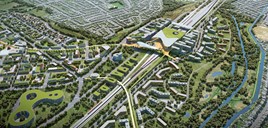A £2.7 billion plan to improve rail, tram and bus connections to the HS2 East Midlands Hub station at Toton has been published by Midlands Connect.
Under the proposals, more than 20 villages, towns and cities across the East Midlands would gain direct access to the HS2 station - including Nottingham, Derby and Leicester.
The plan has been split into three stages, so that economic development can be stimulated before HS2 Phase 2b is completed and the first trains arrive in the East Midlands by 2040.
The first phase of the scheme, earmarked for completion by 2030, includes an extension of Nottingham’s tram network from Toton Lane to Long Eaton, via two new stops at the HS2 station and a planned Innovation Campus.
The second phase includes £1.2bn worth of proposals to build a new station at East Midlands Airport and connected to the Midland Main Line, plus a possible tram extension to Derby. This could be completed by 2040.
A £1.05bn suite of phase three improvements will establish new rail links to South Derby Growth Zone. Tram-train services to Long Eaton, Ratcliffe-on-Soar power station and East Midlands Gateway logistics site could follow five years later.
According to MC Chairman Sir John Peace, the £2.7bn investment package is vital not only to maximise the growth opportunities presented by HS2, but also to stimulate a recovery throughout the region from the economic impacts of the COVID-19 pandemic.
It would also help to level up annual transport spending across the country - it is currently some 49% lower per head of population in the East Midlands (£245) than the UK average (£483).
- For the FULL story, read RAIL 906, published on June 3, and available digitally from May 30.
















Login to comment
Comments
M Choksey - 25/06/2020 17:38
The Tyne and Wear metro system opened in 1980, and has been an unqualified success. It made use of old railway lines. It has linked communities and created a coherent conurbation. There is a similar opportunity in the Midlands. There are lines used only occasionally: others which still exist, although fallow. There are old small local stations which could be re-furbished. Above all, the area could become a thriving metropolis, linking London to the NE and NW. Environmentally, any electrified transport system which takes cars off the roads must be wort a long-term vision and corresponding investment.